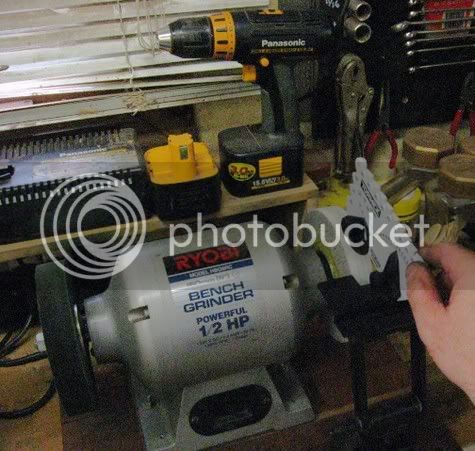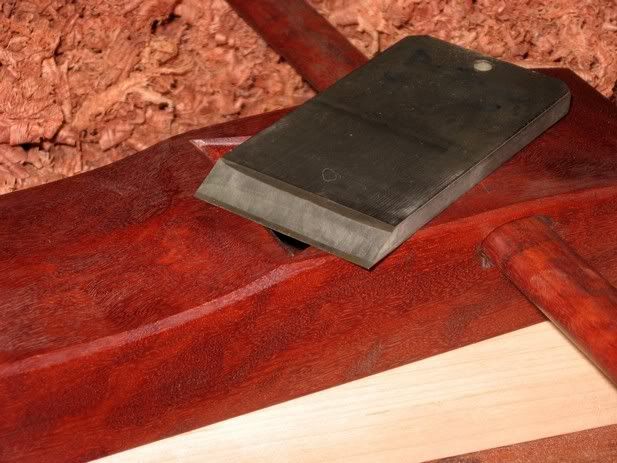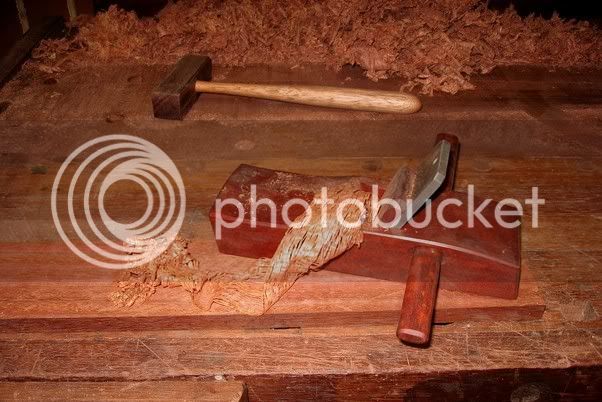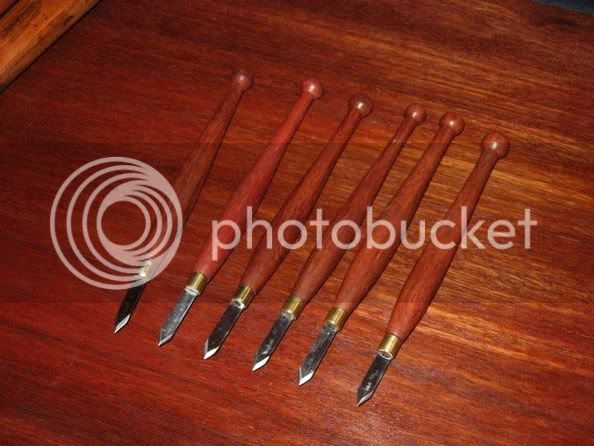You are using an out of date browser. It may not display this or other websites correctly.
You should upgrade or use an alternative browser.
You should upgrade or use an alternative browser.

Help Support UKworkshop.co.uk:
This site may earn a commission from merchant affiliate
links, including eBay, Amazon, and others.
woodbloke
Established Member
Sgain Dubh wrote:
This degree off sharpness is easily and effortlessly achieved with the DMT diamond stone/jeweller's rouge strop as Waka will testify when he took allot of hair from his arm in my 'shop the other day :lol:
I've just been doing a load of d/t's for the elm chest and I haven't even bothered to touch up the chisel on the DMT stone, all I have done is to strop the bevel half a dozen times, wipe off the goo and polish the flat side on the stone, about 5 seconds in all. This is the same technique that a woodcarver will use to constantly keep on re-honing/polishing the edge on carving gouges and the like...great story tho' - Rob
You could shave with it. I know, because he demonstrated how sharp it was by slicing a few hairs off his forearm.
This degree off sharpness is easily and effortlessly achieved with the DMT diamond stone/jeweller's rouge strop as Waka will testify when he took allot of hair from his arm in my 'shop the other day :lol:
I've just been doing a load of d/t's for the elm chest and I haven't even bothered to touch up the chisel on the DMT stone, all I have done is to strop the bevel half a dozen times, wipe off the goo and polish the flat side on the stone, about 5 seconds in all. This is the same technique that a woodcarver will use to constantly keep on re-honing/polishing the edge on carving gouges and the like...great story tho' - Rob
Frank D.
Established Member
The problem I've found with rouge and strops is that you have to strop the backs of blades for it to be effective, which means rounding them over slightly. So on a plane blade you lose clearance and on a chisel you lose the flat back. Slight rounding over isn't critical, if it isn't desirable, on carving gouges because you have bevels on both sides.
I have no problems wearing my stones evenly with a guide...I just use a side-to-side motion instead of other fancy figures on half the stone as has been stated, then turn the stone around after a while and continue.
I know I'm slow but I still don't quite understand Mr Grimsdale's method. It seems to me that you have to take off a certaain amount of metal no matter how you go about it--guide or not, rounded or not. The only real shortcut is increasing the angle as you round off the bevel, which merely leaves you with more metal to take off next time (so there's no real shortcut).
I have no problems wearing my stones evenly with a guide...I just use a side-to-side motion instead of other fancy figures on half the stone as has been stated, then turn the stone around after a while and continue.
I know I'm slow but I still don't quite understand Mr Grimsdale's method. It seems to me that you have to take off a certaain amount of metal no matter how you go about it--guide or not, rounded or not. The only real shortcut is increasing the angle as you round off the bevel, which merely leaves you with more metal to take off next time (so there's no real shortcut).
Sgian Dubh
Established Member
Alf":2rxqyu8n said:- I'm sure you resisted last time I tried getting you to post this, Richard. Cheers, Alf
I didn't see your coaxing effort last time Alf. I miss a lot being primarily a one minute skimmer when I visit the forum. I haven't got the time to loiter really.
Anyway, sharp is sharp. Who cares how you get there-- so long as it's quick. I haven't got much patience for sharpening. Just a quick, "How's yer father?" and back to work has always been my style-- no jigs and very basic. Slainte.
A
Anonymous
Guest
dchenard":1ia42hvo said:Frank D.":1ia42hvo said:Open wide Denis,
I use the LV Mk I most of the time (except for my #8 and 112 blades, and narrow chisels).
Well, Quick-draw McGraw, I've never been that fast with setting my Mk. I jig...
Nothing odd in what Frank says - I get my blades or chisles in the mk2 LV guide in under 20 seconds every time. The registration is built in.
Free hand is fine if you like it but I do not think is quicker and I do not think the edge is as good every time when sharpening freehand. Jig gives consistency, particularly mk2 LV
A
Anonymous
Guest
sgian, I cant work out if your anecdot was done with an oierish or a scorts arksent :wink: :lol: It certainly wurssent yarksher :lol:

£17.99 (£1.80 / count)
£27.44 (£2.74 / count)
3M 8822 Disposable-fine dust mask FFP2 (10-pack)
Amazon.co.uk

£26.99 (£1.35 / count)
VEVOX® FFP2 Dust Mask - Set of 20 - Valved Face Masks - Respirator - Protection e.g. for Construction, Building Work, Sanding, Woodworking, Fine Dusts, Aersoles or Particles
SLSK Ventures GmbH (UK)

£12.50 (£1.25 / count)
£14.45 (£1.44 / count)
JSP M632 FFP3moulded Disposable Dustmask (Box of 10) One Size suitable for Construction, DIY, Industrial, Sanding, dust protection 99 Percent particle filtration Conforms and Complies to EN 149
Amazon.co.uk

£19.46 (£3.89 / count)
£19.99 (£4.00 / count)
Stealth Lite Pro FFP3 Face Masks UK Certified Dust Mask. 99.99% particle filtration, air filter reusable face mask. FFP3 Mask -7 day use per Construction, Woodworking, DIY and Welding Mask
Amazon.co.uk
dchenard
Established Member
Tony":vtfr195d said:Jig gives consistency, particularly mk2 LV
True, so does practising freehand honing
DC
David C
In Memorium
"The opening sequence of David Charlesworth's latest DVD shows him securing a chisel in a honing guide and putting the tool to the stone for four strokes. He adjusts the tool in the jig, cleans the jig's wheel and takes four more strokes on a polishing stone. Two more strokes polish the unbeveled side of the chisel and then he shaves his left wrist for the camera.
Total elapsed time: 1:21."
"The most shocking thing about the DVD for many woodworkers will be to see how few strokes Charlesworth uses when honing. Four or five on each grit, maybe. I watch some woodworkers do 50 to 100 strokes on a single grit. I've always thought this is an enormous waste of effort, so it's good to see this lesson reinforced."
Two quotes from a review of DVD 4 posted by Chris Schwarz on the Popular Woodworking blog or is it news. You have to scroll down quite far to find it now.
htttp://www.popularwoodworking.com/blog/default.aspx
I use an Eclipse type side clamping guide, three King Japanese waterstones and can teach a beginner to get chisels exactly as sharp as mine in one day.
All other methods work, it is just a case of finding what suits you and gets the job done quickly & efficiently, exactly as Richard and others say.
best wishes,
David Charlesworth
PS Chris has slightly exaggerated the speed, for journalistic purposes. On the seventh resharpening between re grinds, I might need about twelve to fifteen strokes on an 800 grit waterstone, and four on a polishing stone.
On the first sharpening after re grind, I would expect to take no more than two strokes on 800g waterstone.
I think I use twelve short to & fro strokes to polish off wire edge.
Just being a wee bit pedantic, as usual, but extremely grateful to Chris who understands what I am getting at.
Total elapsed time: 1:21."
"The most shocking thing about the DVD for many woodworkers will be to see how few strokes Charlesworth uses when honing. Four or five on each grit, maybe. I watch some woodworkers do 50 to 100 strokes on a single grit. I've always thought this is an enormous waste of effort, so it's good to see this lesson reinforced."
Two quotes from a review of DVD 4 posted by Chris Schwarz on the Popular Woodworking blog or is it news. You have to scroll down quite far to find it now.
htttp://www.popularwoodworking.com/blog/default.aspx
I use an Eclipse type side clamping guide, three King Japanese waterstones and can teach a beginner to get chisels exactly as sharp as mine in one day.
All other methods work, it is just a case of finding what suits you and gets the job done quickly & efficiently, exactly as Richard and others say.
best wishes,
David Charlesworth
PS Chris has slightly exaggerated the speed, for journalistic purposes. On the seventh resharpening between re grinds, I might need about twelve to fifteen strokes on an 800 grit waterstone, and four on a polishing stone.
On the first sharpening after re grind, I would expect to take no more than two strokes on 800g waterstone.
I think I use twelve short to & fro strokes to polish off wire edge.
Just being a wee bit pedantic, as usual, but extremely grateful to Chris who understands what I am getting at.
A
Anonymous
Guest
You must enter a message when posting
Colin C
Established Member
Frank D.":290sqp5l said:The problem I've found with rouge and strops is that you have to strop the backs of blades for it to be effective, which means rounding them over slightly.
Hi Frank,
I used to get this when I had my oil stone ( one of the reasons that I now use a daimond stone ) but with a strop it is much smaller if much at all
Frank D.
Established Member
Thanks Colin,
I'll have to keep at it. I'm also going to try turning the leather around and use the smooth side up.
I'll have to keep at it. I'm also going to try turning the leather around and use the smooth side up.
David C
In Memorium
Without the guide, the angles would not be maintained, especially by beginners.
David C
David C
woodbloke
Established Member
Frank D. wrote:
The problem I've found with rouge and strops is that you have to strop the backs of blades for it to be effective, which means rounding them over slightly.
Only the bevel side is stropped, the flat side is polished on the DMT stone so there is no effective rounding. Rouge is such a fine polish that the degree of rounding on the bevel edge side is insignificant - Rob
bugbear
Established Member
Mr_Grimsdale":3gd5oj4a said:Er, sorry David I seem to have missed the point. That's 10 strokes - at a leisurely pace freehand that'd take about 5 secs. Here it's taking 81 secs. 16x too long. Something is seriously holding up the job! Time to bin the honing guide?David C":3gd5oj4a said:"The opening sequence of David Charlesworth's latest DVD shows him securing a chisel in a honing guide and putting the tool to the stone for four strokes. He adjusts the tool in the jig, cleans the jig's wheel and takes four more strokes on a polishing stone. Two more strokes polish the unbeveled side of the chisel and then he shaves his left wrist for the camera.
Total elapsed time: 1:21."snip
cheers
Jacob
Apples and Oranges, old boy. The whole point (IMHO) of jigged sharpening is that you can exactly and consistently hit the same tiny (secondary) bevel every time. That's why the stroke count can be so low, and the sharpening pleasingly quick. It also maximises the life of the tool, by minimising the amount of metal removed.
With freehand you need more strokes because you can't guarantee the honing angle accurately; some of the (fast) strokes are just wasted.
In particular (and obviously?), any stroke at an angle other than the final bevel has no effect on the edge.
BugBear
A
Anonymous
Guest
You must enter a message when posting
dchenard
Established Member
David C":pdszwexq said:Without the guide, the angles would not be maintained, especially by beginners.
David C
Quite possibly, but all those who have developed proficiency in freehand sharpening were beginners at some point... :wink:
DC (the next generation :lol: )
Derek Cohen (Perth Oz)
Established Member
Boys and girls! Play nicely in the sandpit, now.
Yes, a honing guide does enable one to repeat a setting.
And a repeated setting means that a fresh face is not honed each time.
Which means that one is not wasting time rediscovering one's bevel.
I have written a fair amount number of articles on the LV Honing Guide Mk II. I am no stranger to the Eclipse. I believe that honing guides have an important place to play.
But....
... there is something emotionally satisfying about honing an edge freehand.
If you are not woodworking for a living (I would starve at the rate I work!), then you are doing it for the pleasure.
Still, it is possible to make freehand honing both accurate and quick. For a start, I reserve the below method for blades used in bevel down planes and most chisels (the exceptions are Japanese and mortice). To maximise the ease of freehand honing, blades require to be hollow ground. It is easier to hold a (bevel) side flat on two points than on one wide point.
For blades used in bevel up planes, it is more important to grind and hone at specific bevel angles than it is for BD planes. I grind a flat bevel on a belt sander, then add microbevels with the LV Honing Guide Mk II.
I hollow grind blades on a 6" high speed grinder (I have toyed with the idea of getting a 8" one but do not know if there is anything to gain - the deeper hollow of the 6" wheel should last longer). It is possible to grind a bevel at a desired angle, should this be important. Well, I do like to use 20 degrees for paring chisels and 30 degrees for plane blades (particularly the HNT Gordon planes). This is easy enough if one uses the Tormek Pro Anglemaster:

Blades set up this way only require a few strokes on 800, then 1200, then 8000 King waterstones. Truly.


Regards from Perth
Derek
Yes, a honing guide does enable one to repeat a setting.
And a repeated setting means that a fresh face is not honed each time.
Which means that one is not wasting time rediscovering one's bevel.
I have written a fair amount number of articles on the LV Honing Guide Mk II. I am no stranger to the Eclipse. I believe that honing guides have an important place to play.
But....
... there is something emotionally satisfying about honing an edge freehand.
If you are not woodworking for a living (I would starve at the rate I work!), then you are doing it for the pleasure.
Still, it is possible to make freehand honing both accurate and quick. For a start, I reserve the below method for blades used in bevel down planes and most chisels (the exceptions are Japanese and mortice). To maximise the ease of freehand honing, blades require to be hollow ground. It is easier to hold a (bevel) side flat on two points than on one wide point.
For blades used in bevel up planes, it is more important to grind and hone at specific bevel angles than it is for BD planes. I grind a flat bevel on a belt sander, then add microbevels with the LV Honing Guide Mk II.
I hollow grind blades on a 6" high speed grinder (I have toyed with the idea of getting a 8" one but do not know if there is anything to gain - the deeper hollow of the 6" wheel should last longer). It is possible to grind a bevel at a desired angle, should this be important. Well, I do like to use 20 degrees for paring chisels and 30 degrees for plane blades (particularly the HNT Gordon planes). This is easy enough if one uses the Tormek Pro Anglemaster:

Blades set up this way only require a few strokes on 800, then 1200, then 8000 King waterstones. Truly.


Regards from Perth
Derek
bugbear
Established Member
Mr_Grimsdale":f6ezicdw said:ALL the other strokes which don't hit the final angle, whether grinding or honing, are backing off the bevel and so making the final bevel possible and easier to obtain.bugbear":f6ezicdw said:snip
In particular (and obviously?), any stroke at an angle other than the final bevel has no effect on the edge.
BugBear
I don't think any of the grits appropriate for honing are going to remove enough material to achieve any significant "backing off".
These (IMHO wasted) strokes are simply polishing something which isn't the edge.
BugBear
bugbear
Established Member
Still, it is possible to make freehand honing both accurate and quick. For a start, I reserve the below method for blades used in bevel down planes and most chisels (the exceptions are Japanese and mortice). To maximise the ease of freehand honing, blades require to be hollow ground. It is easier to hold a (bevel) side flat on two points than on one wide point.
Yes - indeed BU blade are thick (which makes for a large bevel to "seat" on) and short (which decreases the moment trying to dislodge the blade from sitting squarely on its bevel).
I am perfectly happy that (e.g.) Japanse plane blades can be freehand honed using single bevel (the traditional Japanese way for these blades).
Bailey blades strike me as more problematic.
BugBear
Derek Cohen (Perth Oz)
Established Member
Bailey blades strike me as more problematic.
BB
Yes they are more difficult. By comparison, freehanding a 1/4" Gordon bevel, a 3/16" parallel infill blade, or a deep 30 degree Japanese chisel is a walk in the park. I do not use many original Stanley plane blades, but I can and do hone these freehand. If any bevel is going to end up rounded, then it will be these as there is less area to register and stabilise the edge. It is inevitable that these get rocked more. If I were only working with these blades then I would have to get better than I am, or I would find myself using a guide more often.
Here are a bunch of marking knives I made up a few days ago. The bevels were all honed freehand. Sometimes it is all that one can do. There is no other choice of method.

Regards from Perth
Derek
Similar threads
- Replies
- 83
- Views
- 4K



























